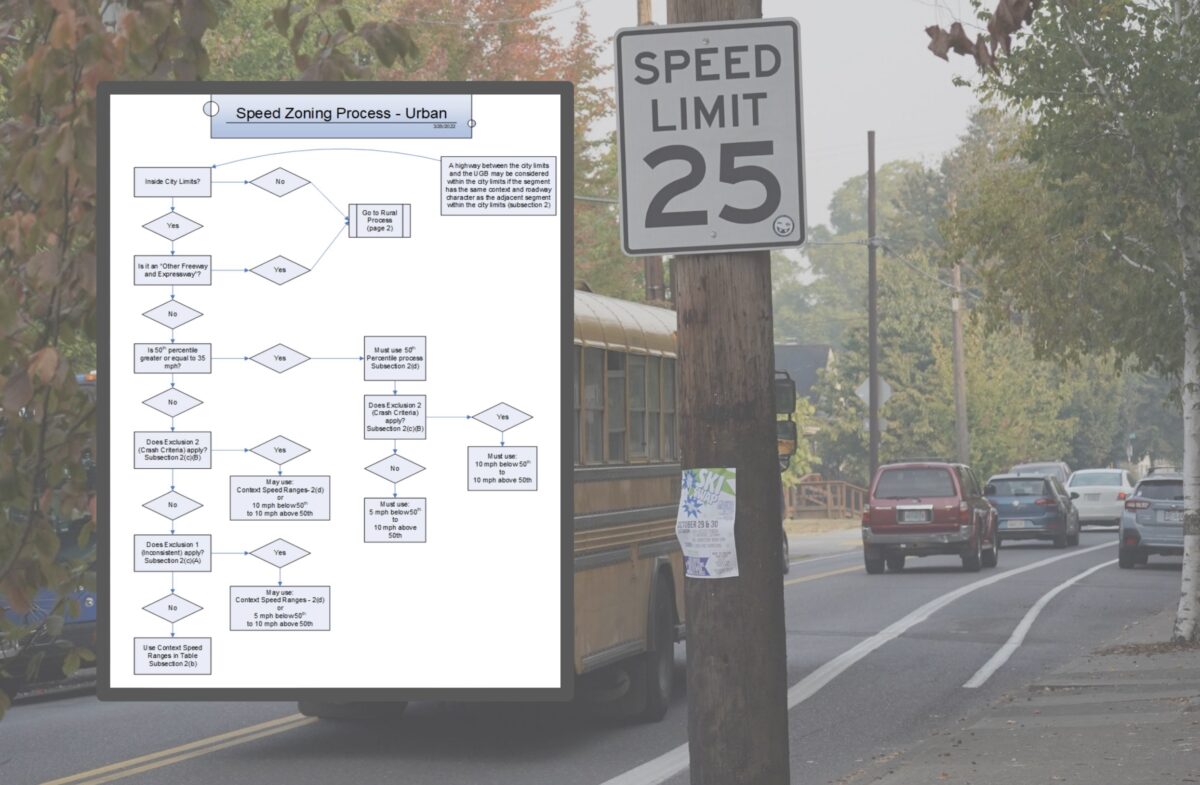Now that the City of Portland has more authority to set its own speed limits, I was curious how it will play out inside the transportation bureau. So I fired off a few questions to Portland Bureau of Transportation (PBOT) Public Information Officer Dylan Rivera.
While I waited to hear back, I noticed that the Oregon Department of Transportation (ODOT) added a trove of information about the new process to their website about how city transportation staff must go about taking advantage of this new authority.
If you’re wonky enough to care about this type of stuff and/or an advocate who wants to better understand the new playbook when it comes to lowering speeds (which in my opinion is an important step regardless of enforcement), I think you’ll appreciate this Q & A.
BikePortland: Has PBOT prepared for this change? If so, how?
Dylan Rivera, PBOT: PBOT was engaged in developing ODOT’s rule for implementing this state law, which we had advocated for in the legislature.
PBOT has played a leading role advocating for local authority to set speed limits on Portland streets for more than five years. Following passage of House Bill 2682 in 2017, which allowed for 20 mph residential speed limits in Portland, in 2018, the City of Portland began advocating in the legislature for local speed setting authority. It wasn’t until 2021 when local delegation finally passed as part of the omnibus transportation bill. In a separate process that ODOT initiated in 2018, PBOT participated in a speed zone roundtable to update the state’s speed setting rules. Speed setting previously was tied to 85th percentile travel speeds during free flow conditions. The updated rules, within cities, consider land use context, street classification and 50th percentile speeds.
ODOT recently published an application form on their website for local speed setting control. PBOT is currently working on our application, which includes submitting a quality control plan. Our application must demonstrate that our staff are qualified, they’ve taken ODOT training and we have the capabilities to follow the required procedures.
What type of staffing changes or internal systems will be created to deal with this need for engineering studies that must now be done at PBOT instead of ODOT?
We’re trying to determine how much work this will entail for our planning and engineering staff. Currently, ODOT makes the decision about speed limit changes that require engineering studies. Sometimes, PBOT can propose a new speed limit and conduct its own study that justifies that request, which is followed by a decision by ODOT. Other times, PBOT can propose a new speed limit and ODOT performs the study, as well as making the decision. The ODOT studies were contingent on ODOT’s staff availability, so could take a year or more to complete.
Under the new system, PBOT could make the decision about the speed limit change on city streets on its own, following state law. This new approach still requires a speed study, but all of them could be conducted by PBOT.
It’s important to remember that the current process applies to any speed limit requests on city streets until PBOT is approved for the new authority. We are not sure how long that process will take.
Will new speed limit requests be taken from anyone outside PBOT?
Requests for speed limit changes can be made to 311 or 823-SAFE and will be evaluated by our staff. This is the longstanding customer intake process we have had. The difference with the new authority is that after PBOT considers the request, we will be able to make the speed limit change as long as we are acting within state law. We also have some PBOT guidance that helps us interpret the law.
The new authority does not apply to state highways in the city limits, such as SE Powell Blvd or Interstate 5.
Any general comment you’d like to make about why this is important and how PBOT will use this new law to make Portland roads safer?
PBOT has long advocated for smarter criteria for setting speed limits. We believe that nationwide and in Oregon, traffic engineers have too often set the speed limit to accommodate the 85th percentile of free-flow traffic, rather than to support multimodal travel in urban environments. The existing criteria for setting speed limits accounts for the changes we have advocated for, including consideration of land use context.
The new authority gives us more control over the timing of speed limit changes, which will help us be more nimble. For example — if we have a project that adds a bunch of new crosswalks, we can more easily combine that project with an adjustment to the speed limit that supports safe use of those new crosswalks. One good example is on NE 47th Avenue north of Columbia Blvd in the Cully neighborhood, funding from a Local Improvement District allowed us to rebuild and redesign the street, building sidewalks and multi-use paths on a street that previously had nothing but ditches by the side of the road. We submitted a request on May 16 for a change from 40 to 30 mph to support this LID project that wrapped up construction a while ago. The street remains 40 mph while this request is being processed. In the future, we’d be more likely to adjust the speed limit closer to when we wrapped up construction on the project.
We do not expect a single, large-scale change as we accomplished with our change of residential speed limits from 25 to 20 mph in 2019. This could help us adjust speed limits on streets in a timely way, as we complete new street redesigns, evaluate street eligibility using the new criteria, respond to requests from the public, and as staff identify opportunities for speed limit reductions throughout the city.
— Check out ODOT’s new Delegated Authority for Speed Zones page to learn more.



